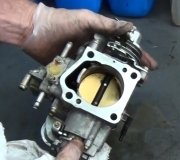I would stick with a factory replacement not a universal a lot less work and you would at least know when the job was done you would haven't to possibly take it apart again.I posted removing the fuel tank and replacing the sending unit.Did you test to see if you had a bad sending unit or are you guessing?Also here is a a/c delco sending unit i found for your car here is the link.Not that hard to change if your used to working on car's.Let me know how it come's out.
http://www.amazon.com/ACDelco-SK1189-Fuel-Tank-Sensor/dp/B000IZ5F1G/ref=au_pf_pfg_s?ie=UTF8&Model=Grand%20Am|596&n=15684181&s=automotive&Make=Pontiac|52&Year=1999|1999&newCar=1&carId=020
1. Disconnect the negative battery cable.
2. Drain the fuel tank. Refer to Fuel Tank Draining Procedure.
CAUTION: Refer to Vehicle Lifting Caution in Service Precautions.
3. Raise the vehicle and suitably support.
4. Grasp the nylon fuel pipe quick-connect fitting. Twist the quick-connect fitting 1/4 turn in each direction to loosen any dirt within fitting. Repeat for the other nylon fuel pipe quick-connect fitting.
CAUTION: Wear safety glasses when using compressed air in order to prevent eye injury.
5. Using compressed air, blow out dirt from the quick-connect fittings at end of the fuel pipes.
6. Disconnect the quick-connect fitting at the fuel filter.
7. Remove the quick connect fittings at the end of the fuel pipe and vapor pipes.
9. Remove the exhaust rubber hangers. Allow exhaust system to rest on rear suspension.
10. Remove the heat shield.
11. Remove the hoses at tank from filler, vent and vapor pipes.
12. With the aid of an assistant, support fuel tank (1) and disconnect the two fuel tank retaining straps.
13. With the aid of an assistant, lower the fuel tank.
14. Remove the fuel tank pressure sensor electrical connector.
15. Remove the fuel sender electrical connector.
16. Remove the tank from the vehicle.
17. Remove the fuel sender assembly from the tank.
INSTALLATION PROCEDURE
IMPORTANT: Inspect all connectors for dirt and burrs. Clean or replace components/assemblies as required. Fuel pipe O-rings for cuts, nicks, swelling or distortion. Replace if necessary.
1. Install the fuel sender assembly to tank.
2. With the aid of an assistant, raise the fuel tank (1) to body.
NOTE: Refer to Fastener Notice in Service Precautions.
3. Install the fuel tank retaining straps.
Tighten
Tighten the bolts to 35 N.m (26 lb ft) .
4. Install the fuel tank pressure sensor electrical connector.
5. Install the fuel tank sender electrical connector.
6. Install the hoses to filler, vent and vapor pipes
7. Install the heat shield.
8. Install the exhaust rubber hangers.
NOTE: Refer to Fastener Notice in Service Precautions.
9. Install the muffler support bolts.
Tighten
Tighten the bolt to 15 N.m (11 lb ft) .
CAUTION: Always apply a few drops of clean engine oil to the male pipe ends before connecting fuel pipe fittings in order to reduce the risk of fire and personal injury.
This will ensure proper reconnection and prevent a possible fuel leak.
During normal operation, the O-rings located in the female connector will swell and may prevent proper reconnection if not lubricated.
10. Install the nylon fuel pipe and fuel filter quick-connect fittings.
11. Lower the vehicle.
12. Refill the tank.
13. Connect the negative battery cable.
14. Inspect for fuel leaks through the following steps:
14.1. Turn the ignition switch to the ON position for two seconds .
14.2. Turn the ignition switch to the OFF position for ten seconds .
14.3. Turn the ignition switch to the ON position
14.4. Check for fuel leaks.
REMOVAL PROCEDURE
1. Relieve fuel system pressure. Refer to Fuel Pressure Relief Procedure.
2. Drain the fuel tank. Refer to Fuel Tank Draining Procedure.
3. Remove the fuel tank.
4. Remove the modular fuel sender assembly.
5. Remove the fuel level sensor from the modular fuel sender.
INSTALLATION PROCEDURE
1. Install the fuel level sensor to modular fuel sender.
2. Install the fuel sender assembly.
3. Install the fuel tank.
4. Refill the fuel tank.
5. Connect the negative battery cable.
6. Inspect for fuel leaks through the following steps:
6.1. Turn the ignition switch to the ON position for two seconds .
6.2. Turn the ignition switch to the OFF position for ten seconds .
6.3. Turn the ignition switch to the ON position
6.4. Check for fuel leaks.
SPONSORED LINKS
Sunday, February 27th, 2011 AT 1:04 AM



